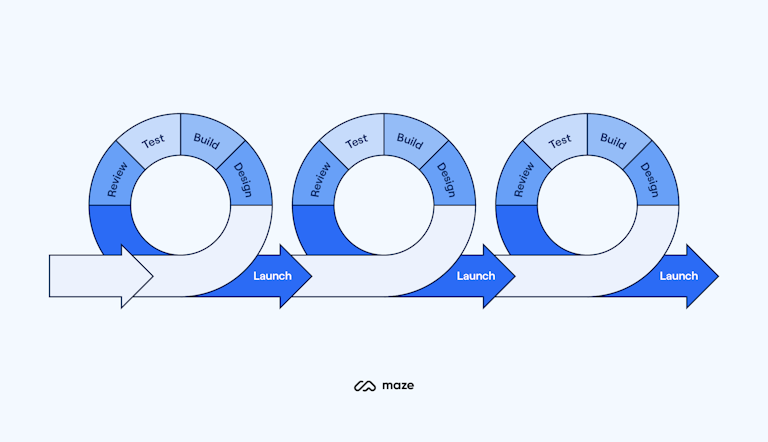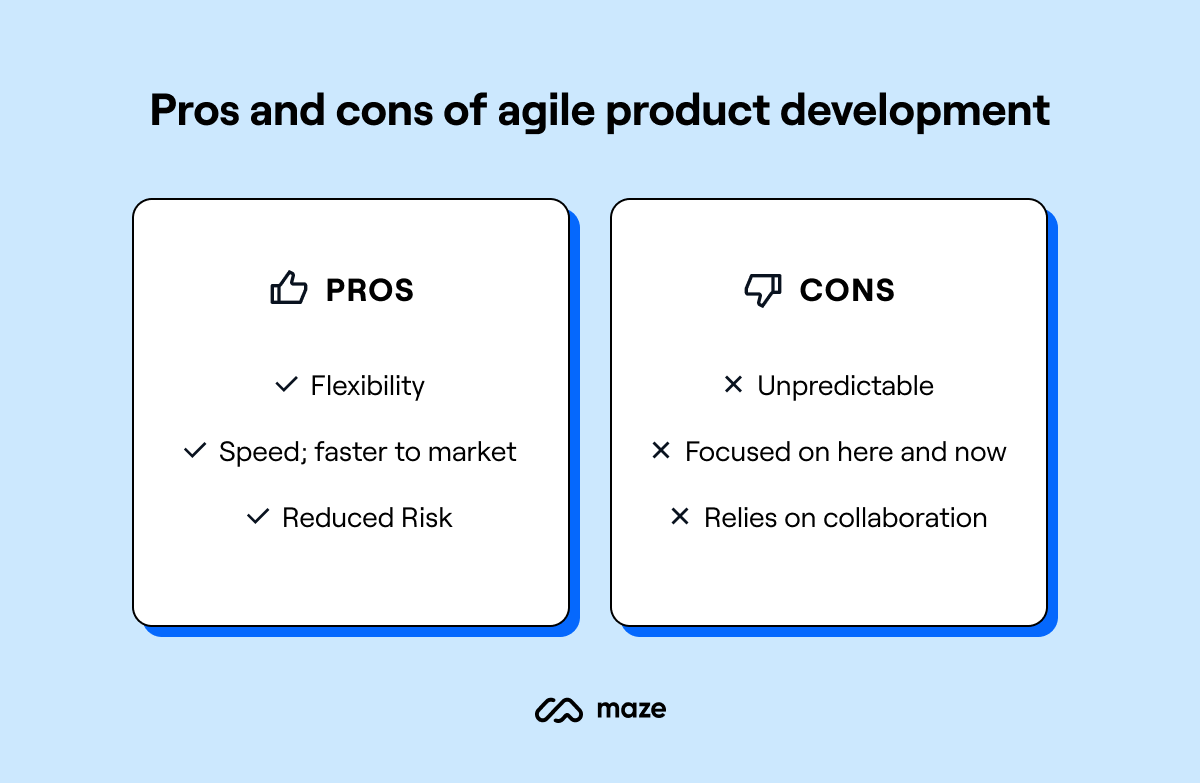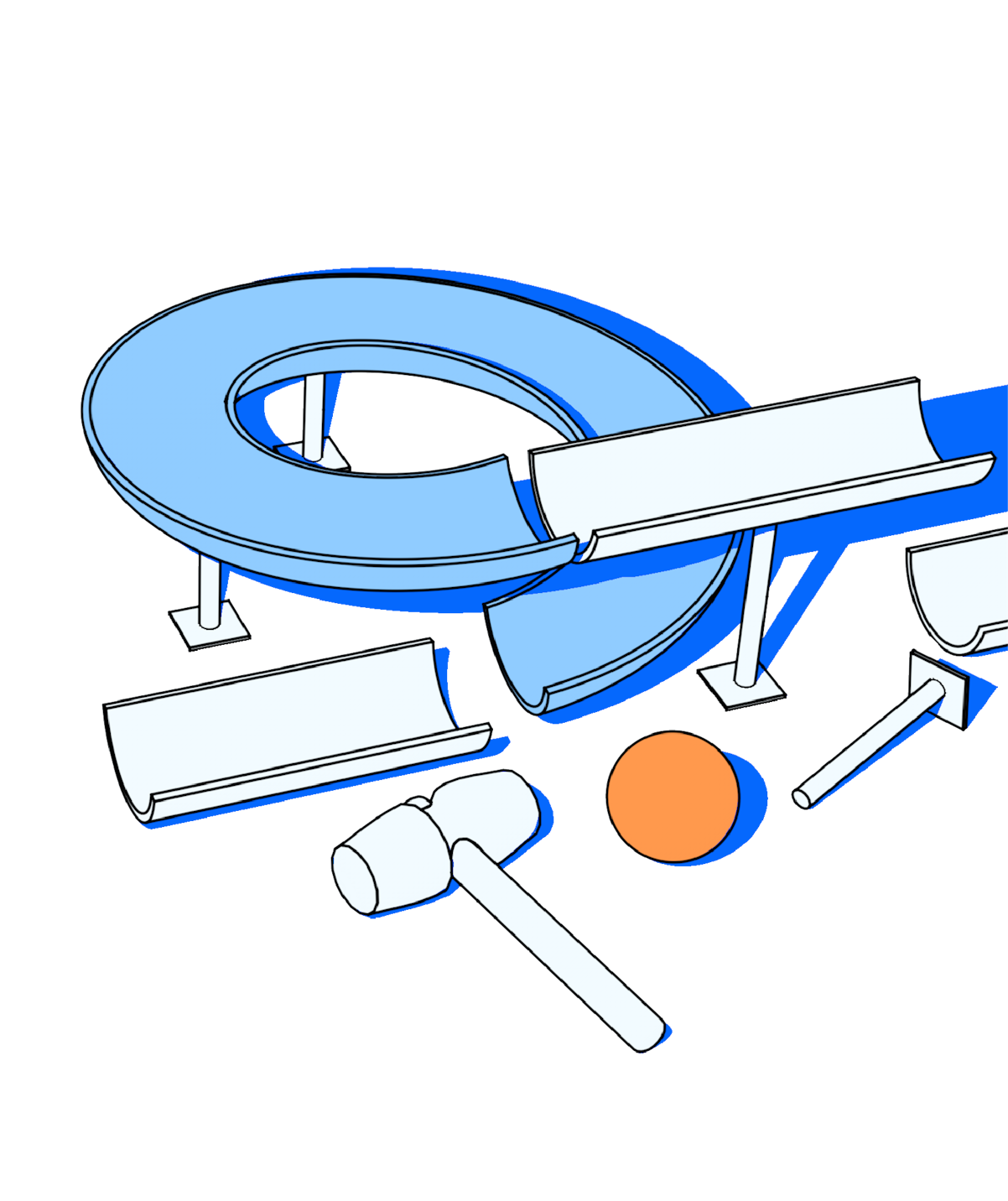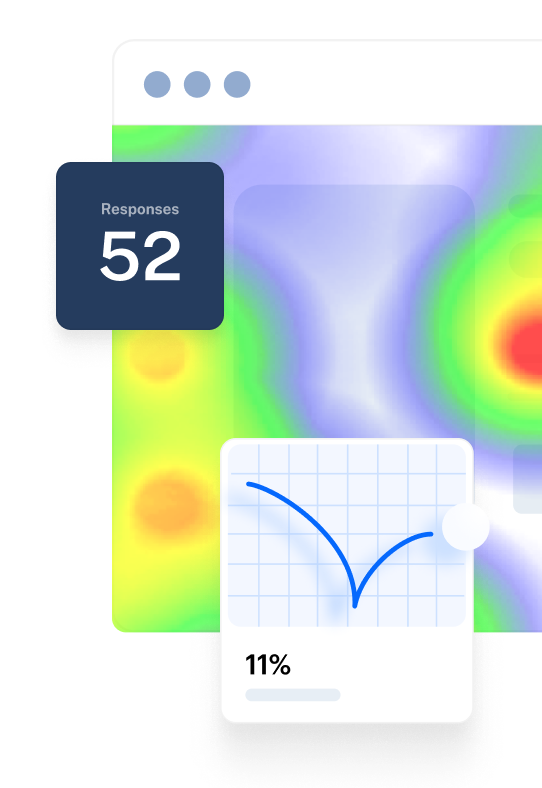Today, companies need to constantly adjust their strategies and products to keep up with evolving markets. Following an Agile product development process can help teams respond effectively to change and develop user-centric products that better suit customers’ needs. Ready to learn more?
In this article, we'll cover what the Agile Methodology is and how it applies to product development. We'll explore and compare Agile and Waterfall methods, analyze the pros and cons of Agile development, and provide a few tips for transitioning to Agile.
What is agile product development methodology?
Agile product development refers to a set of product development practices and methods based on the principles and values of the Agile Manifesto. In Agile product development, teams build products using short iterations that enable continuous feedback and rapid improvement.
The Agile methodology is an iterative approach to project management that focuses on breaking down projects into smaller, more manageable tasks. Compared to traditional project management approaches like Waterfall, Agile prioritizes speed, flexibility, cross-team collaboration, and frequent feedback. Teams continuously evaluate requirements, progress, and results, so they can respond to change quickly.
The product development process is divided into sprints or iterations—short and periodic time frames that usually last from one to four weeks. Each sprint starts with a planning meeting where cross-functional teams come together to discuss and prioritize the work that needs to be done.
Every iteration is like a small project that includes all the stages of the product development process, from product discovery to release. Once the sprint ends, the product team presents a working product, or Minimum Viable Product (MVP), to customers and stakeholders. The goal is to create something simple that they can iterate on based on users’ feedback. It might take multiple iterations before launching the final feature or product to market.

The agile product development process
Agile became popular in 2001 when a group of 17 software developers published the Manifesto for Agile Software Development. Their goal was to optimize the software development process and find a way to quickly identify and correct problems.
Although typically associated with software development, the Agile methodology has successfully expanded to other areas, including product development.
The 12 principles of agile product development & management
The Agile Manifesto lays out 12 principles that describe the Agile mindset. Below we’ll review each of them and explain how they can be adapted to product development.
1. Satisfy customers through early and continuous delivery
Our highest priority is to satisfy the customer through early and continuous delivery of valuable software.
Iteration and customer feedback are at the core of the Agile methodology. Product managers focus on delivering a working product, ideally an MVP, as soon as possible. The goal is to get feedback from real customers and use those insights to inform future releases and improve the product.
2. Welcome changing requirements
Welcome changing requirements, even late in development. Agile processes harness change for the customer’s competitive advantage.
Customer needs, the marketplace, and competition are constantly evolving. In this dynamic context, companies need to embrace change to remain competitive. While traditional approaches to product development view changing requirements as a threat, Agile product teams consider them an opportunity to increase the chance of delivering superior value to the customer.
3. Deliver working products frequently
Deliver working software frequently, from a couple of weeks to a couple of months, with a preference to the shorter timescale.
Agile product development focuses on shortening the gap between initial planning and delivery. Delivering working products frequently to customers allows teams to collect product feedback early, evaluate their course, and make changes if needed.
4. Encourage regular communication
Business people and developers must work together daily throughout the project.
Agile encourages regular communication and collaboration between product teams and business stakeholders. Daily stand-ups and sprint planning, review, and retrospective meetings are just a few ways to bring everyone on the same page and align the product goals with business objectives.
5. Build projects around motivated individuals
Build projects around motivated individuals. Give them the environment and support they need, and trust them to get the job done.
Another key aspect of the Agile methodology is to empower individuals and product teams through autonomy and trust. With the right environment, product management tools, and support, people will do their best work and produce quality outcomes. The most important thing is to make sure that everyone understands the product strategy and the underlying business motivation.
6. Choose face-to-face conversation whenever possible
The most efficient and effective method of conveying information to and within a development team is face-to-face conversation.
Due to the increasing number of distributed or remote teams, 'face-to-face conversation' can be interpreted as 'synchronous communication.' In the end, the goal behind this principle is to encourage real-time communication about the product to avoid misunderstandings and delays.
7. Measure progress with working versions of the final product
Working software is the primary measure of progress.
Rather than releasing a final, perfect product, Agile product development involves delivering many versions of the product until arriving at a final version that meets all the requirements. The only way to measure progress is to have a working product that users can test out.
8. Promote sustainable product development
Agile processes promote sustainable development. The sponsors, developers, and users should be able to maintain a constant pace indefinitely.
Breaking down processes into small and achievable milestones helps product teams set realistic goals and clear expectations. The idea is to keep team members motivated, improve work-life balance, and avoid burnout and turnover.
9. Pay attention to technical excellence and good design
Continuous attention to technical excellence and good design enhances agility.
The goal of Agile is to create not just a working product but also a high-quality solution. When teams pay attention to the technical quality and design after each iteration, they can fix issues early and avoid problems in the future.
10. Keep it simple
Simplicity—the art of maximizing the amount of work not done—is essential.
This Agile principle invites product teams to focus their efforts on what is essential to create value. An example of how product teams apply this principle to product development is the creation of a Minimum Viable Product— an early version of a product with just enough features to attract early customers and validate the product idea.
11. Self-organizing teams generate the most value
The best architectures, requirements, and designs emerge from self-organizing teams.
Self-organizing teams decide as a group how they will accomplish their work, rather than waiting for a manager to tell them what to do. Giving teams a high-level direction and letting them organize and manage themself boosts motivation and engagement and speeds up decision-making.
12. Regularly reflect on how to be more effective
At regular intervals, the team reflects on how to become more effective, then tunes and adjusts its behavior accordingly.
Agile is about constant improvement, and this philosophy also applies to processes and teams. Most Agile frameworks, such as Scrum or Kanban, include a retrospective at the end of each sprint. This is a great opportunity to evaluate what went well and what didn’t and understand how to improve the process in the future.
At Maze, after each build cycle, we organize a retrospective with the development team and stakeholders to discuss what worked and what could be improved. Learn more about our current product development process.
What's the difference between agile and waterfall?
Now that we covered the basics of Agile, let's see how it compares to the more traditional Waterfall approach.
The main difference between Agile and Waterfall is that the Waterfall approach breaks down the project into linear, sequential phases. Each phase begins when the previous one is completed, and there's no overlapping in the stages. On the contrary, Agile divides a project into sprints and promotes continuous development and testing in the product development process.
Other differences include:
- Flexibility vs. rigid approach. While Agile allows teams to address new requirements, in a Waterfall project, requirements are defined at the outset and are unlikely to change.
- Continuous testing vs. final testing. Agile development teams perform testing after every iteration, whereas Waterfall teams only test the product once finalized.
- Frequent deliveries vs. end-of-project delivery. Agile encourages fast and regular deliveries, enabling immediate user feedback. On the other hand, with the traditional model, customers can only see the product at the end of the project.
Tip 💡
A well-defined product development strategy gives you a clear direction to follow, enabling you to optimize your resources and focus them on what is most important.
The pros and cons of agile product development
Like any other development methodology, Agile has its strengths and weaknesses. Here we outline some of them.
The pros
- High flexibility. Continuous delivery and constant iterations allow product teams to adjust or shift priorities as the project moves forward. Agile teams can adapt to change rapidly and tailor the product to the customers' expectations.
- Reduced risk. As testing is run at the end of each sprint, product teams can identify problems early and solve them before they become major issues. The fast feedback loops help them validate assumptions and understand what adds real value to the customer.
- Faster time-to-market. Agile teams deliver smaller and more frequent releases to customers. Reducing the time to market gives companies a competitive advantage—they can collect more frequent feedback and react faster to market changes.
The cons
- Less predictability. Agile values responding to change rather than following a plan. The possibility to adjust requirements and priorities as the project evolves makes it harder to predict efforts like cost, time, and resources needed.
- More time and dedication. Agile product development demands a considerable commitment from everyone involved in the project. Cross-functional teams need to communicate and collaborate on an ongoing basis to evaluate what is working and what needs improvement.
- Lack of long-term planning. An Agile project can run the risk of losing direction, going off track, or falling behind schedule due to frequently changing requirements.

The pros and cons of agile product development
Key tips for a successful agile product development process
Fast and efficient product development becomes a competitive advantage in an ever-changing market. By following an Agile methodology, you and your product team will be able to respond quickly to shifting customer needs and adjust the direction as needed.
More and more companies are recognizing the benefits of Agile product development. But what are the best ways to transition to an Agile process? Here are a few tips to keep in mind:
- Agile is, first and foremost, a mindset. Make sure everyone in the team understands and fully embraces the Agile values and principles.
- Encourage team members to communicate and collaborate often. The alignment of goals and priorities is vital for the success of a cross-functional team.
- Promote continuous improvement. Try the Agile approach with smaller projects at first, experiment with different practices, and discuss what works best for you with your team.
- Test early and often. Incorporate tests at every stage of the product development process to get real-time feedback that helps you iterate and improve.
Frequently asked questions
What is Agile product development?
What is Agile product development?
Agile product development refers to the process of building a product using the Agile methodology. Agile product development breaks down the project into short developmental cycles called sprints. After each iteration, product teams deliver a working product to customers to get feedback and make changes accordingly.
What are the 12 principles of Agile?
What are the 12 principles of Agile?
The Agile Manifesto outlines 12 core principles that form the foundation of the Agile mindset, such as 'satisfying the customer through early and continuous delivery,' 'welcoming changing requirements, even late in development,' or 'building projects around motivated individuals.' The Agile principles underpin every successful Agile project and help teams put the Agile methodology into practice.
Is Agile only for software development?
Is Agile only for software development?
Although the Agile methodology was initially designed for software development, it can be applied to most projects regardless of the industry. Due to its flexibility, Agile has expanded beyond software development and is now used in product development, marketing, sales, and more.





